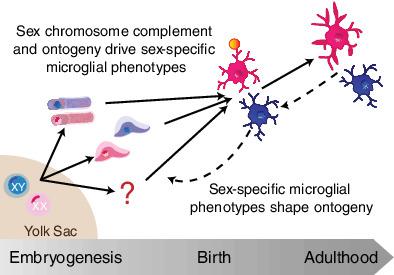Our official English website, www.x-mol.net, welcomes your feedback! (Note: you will need to create a separate account there.)
Microglia and sexual differentiation of the developing brain: A focus on ontogeny and intrinsic factors.
Glia ( IF 6.2 ) Pub Date : 2019-11-19 , DOI: 10.1002/glia.23753 Evan A Bordt 1 , Alexis M Ceasrine 2 , Staci D Bilbo 1, 2
Glia ( IF 6.2 ) Pub Date : 2019-11-19 , DOI: 10.1002/glia.23753 Evan A Bordt 1 , Alexis M Ceasrine 2 , Staci D Bilbo 1, 2
Affiliation

|
Sexual differentiation of the brain during early development likely underlies the strong sex biases prevalent in many neurological conditions. Mounting evidence indicates that microglia, the innate immune cells of the central nervous system, are intricately involved in these sex-specific processes of differentiation. In this review, we synthesize literature demonstrating sex differences in microglial number, morphology, transcriptional state, and functionality throughout spatiotemporal development as well as highlight current literature regarding ontogeny of microglia. Along with vanRyzin et al. in this issue, we explore the idea that differences in microglia imparted by chromosomal or ontogeny-related programming can influence microglial-driven sexual differentiation of the brain, as well as the idea that extrinsic differences in the male and female brain microenvironment may in turn impart sex differences in microglia.
中文翻译:

发育中大脑的小胶质细胞和性别分化:关注个体发育和内在因素。
早期发育过程中大脑的性别分化可能是许多神经系统疾病中普遍存在的强烈性别偏见的基础。越来越多的证据表明,小胶质细胞(中枢神经系统的先天免疫细胞)错综复杂地参与了这些性别特异性分化过程。在这篇综述中,我们综合了证明小胶质细胞数量、形态、转录状态和功能在整个时空发育过程中存在性别差异的文献,并重点介绍了当前有关小胶质细胞个体发育的文献。与 vanRyzin 等人一起。在本期杂志中,我们探讨了这样一种观点,即染色体或个体发育相关编程所赋予的小胶质细胞差异会影响小胶质细胞驱动的大脑性别分化,
更新日期:2019-11-19
中文翻译:

发育中大脑的小胶质细胞和性别分化:关注个体发育和内在因素。
早期发育过程中大脑的性别分化可能是许多神经系统疾病中普遍存在的强烈性别偏见的基础。越来越多的证据表明,小胶质细胞(中枢神经系统的先天免疫细胞)错综复杂地参与了这些性别特异性分化过程。在这篇综述中,我们综合了证明小胶质细胞数量、形态、转录状态和功能在整个时空发育过程中存在性别差异的文献,并重点介绍了当前有关小胶质细胞个体发育的文献。与 vanRyzin 等人一起。在本期杂志中,我们探讨了这样一种观点,即染色体或个体发育相关编程所赋予的小胶质细胞差异会影响小胶质细胞驱动的大脑性别分化,


























 京公网安备 11010802027423号
京公网安备 11010802027423号